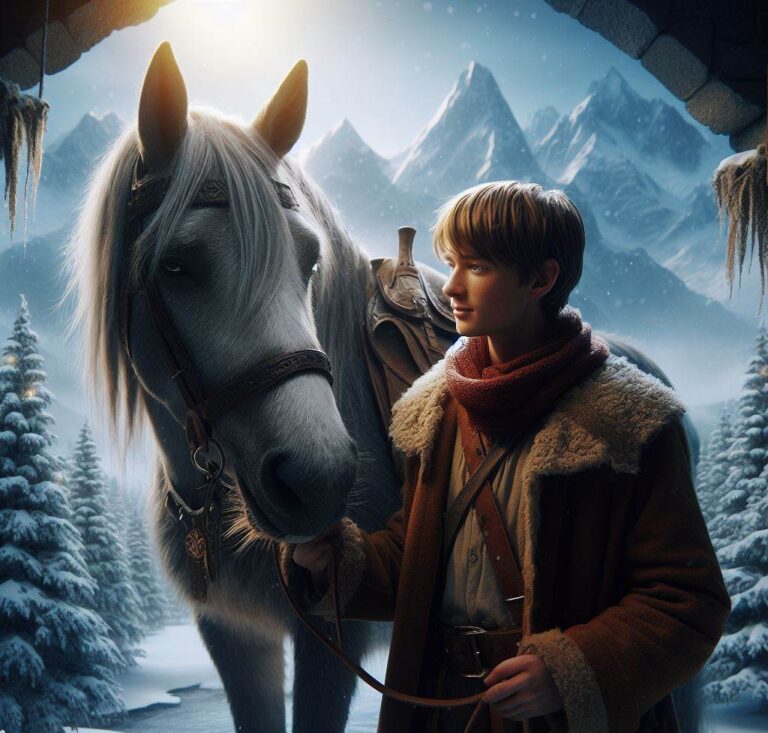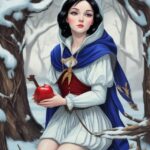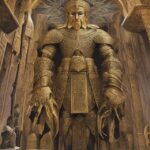Imagine a world where talking horses roam freely, where diverse cultures clash and blend against the backdrop of sweeping landscapes. A riveting tale of adventure, friendship, and self-discovery, “The Horse and His Boy” by renowned author C.S. Lewis takes us on a captivating journey through a world unlike our own. Set in the enchanting land of Narnia, this hidden gem in Lewis’ beloved Chronicles of Narnia series has garnered a devoted following over the years, and for good reason. Whether you’re a fan of Lewis’ imaginative universe or a curious reader seeking a remarkable story, join us as we delve into the heart of “The Horse and His Boy,” guaranteed to leave you wanting more.
So, fasten your seatbelts, open your minds, and get ready to embark on an unforgettable adventure – one that will keep you hooked until the very last page.
The Horse and His Boy: Full Book Summary
Once upon a time, in a magical land called Narnia, there lived a boy named Shasta. Shasta lived a simple life as a fisherman’s son, but he always felt like he was meant for something greater. Little did he know that an incredible adventure was about to unfold, one that would change his life forever and introduce him to the majestic creatures of Narnia.
One stormy night, Shasta stumbled upon a talking horse named Bree. To his astonishment, the horse revealed that it was a Narnian horse who had been kidnapped as a foal and taken to the land of Calormen. Bree longed to return to Narnia, a land of freedom and talking animals, and he proposed that he and Shasta escape together.
Overcoming their fears, Shasta and Bree set out on a daring journey across the vast desert towards Narnia. Along the way, they encountered danger, met peculiar creatures, and formed unlikely friendships with others who were striving for freedom.
Their first encounter came when they met a courageous girl named Aravis, who was escaping from an arranged marriage in Calormen. Aravis rode a talking mare named Hwin, who had also been taken from Narnia. Together, the four companions continue their journey, all with different motives but the same desire for liberty.
As they ride through the scorching desert of Tashbaan, the capital city of Calormen, they witness the grandeur and opulence of the Calormene culture. The group disguises themselves as peasants to avoid suspicion and travels through the bustling streets, feeling both excitement and trepidation.
During their travels, Shasta and Aravis overheard a sinister plot in the house of the powerful Tisroc, the ruler of Calormen. They discovered that a surprise attack was being planned on Narnia by Calormen forces. Fearful for their beloved homeland, the four friends determined to reach Narnia in the hopes of warning the noble king, High King Peter and his siblings.
In their quest, the group ventured into the vast wilderness of Archenland, a neighboring country to Narnia. Little did they know, they were being pursued by an army of Calormenes. Luckily, they were assisted by an old hermit named King Lune, ruler of Archenland, and his loyal subjects. King Lune welcomed them into his castle, where they had a chance to rest and recover from their arduous journey.
Determined to fulfill their mission, Shasta, Bree, Aravis, and Hwin continued onward towards Narnia. Along the way, they encountered a cunning lion named Aslan, who, unbeknownst to them, was the true ruler of Narnia and a symbol of ultimate goodness and power. Aslan guided and protected them throughout their journey, and they learned to trust in his guidance.
Finally, the four friends arrived in Narnia just in time to warn High King Peter and his siblings of the impending attack. The Narnians gathered their forces and prepared to defend their land against the treacherous Calormenes. Shasta met King Edmund, Queen Lucy, and Queen Susan, who were amazed by his bravery and the story of his escape from Calormen.
The battle between Narnia and Calormen commenced, with Shasta and his friends fighting alongside the Narnians. Aslan led the charge, and his mighty presence instilled courage in every heart. Despite the odds, Narnia emerged victorious, defeating the Calormenes and preserving the freedom of Narnia.
In the aftermath of the battle, Shasta was revealed to be the long-lost prince of Archenland, and King Lune joyfully embraced him as his son. Shasta discovered that he was not just an ordinary boy but a rightful heir to the throne, destined for greatness. This revelation filled him with a sense of purpose and belonging.
In the end, Shasta realized that his journey was not just about escaping from Calormen but about discovering his true identity and finding his place in the world. With the love and support of his newfound family and the Narnians, Shasta embraced his role as the future king of Archenland, ensuring peace and prosperity in the land he now called home.
As the book concludes, the reader is left with a sense of wonder and awe at the magical world of Narnia, where true heroes are born, where talking animals roam, and where every journey leads to self-discovery and a greater understanding of one’s purpose in life.
The Horse and His Boy: Key Themes
“The Horse and His Boy” is the fifth book in C.S. Lewis’s famous “Chronicles of Narnia” series. The story revolves around a young boy named Shasta and his talking horse, Bree, who embark on a journey to escape their harsh lives in Calormen and find freedom in the magical land of Narnia. Tackling various themes, three key ones are:
1. Identity: Throughout the book, the theme of identity is explored through the character of Shasta. Shasta grows up as an orphan, unaware of his true heritage. As he embarks on his journey to Narnia, he discovers his rightful identity as the lost Prince Corin of Archenland. The story emphasizes the importance of knowing one’s true self and embracing one’s heritage, as it is the gateway to personal growth and purpose.
2. Freedom and Self-determination: Another significant theme in “The Horse and His Boy” is freedom. Both Shasta and Bree seek to escape their oppressive lives and yearn for freedom, which they hope to find in Narnia. The characters strive to take control of their own lives and make choices that lead them towards a life of liberation. This theme highlights the power of individual agency and the pursuit of freedom as an essential aspect of human existence.
3. Cultural Differences and Prejudice: The book also delves into the theme of cultural differences and prejudice. As Shasta and Bree journey through different lands and encounter various characters, they experience prejudice, stereotypes, and discrimination based on their origins and appearances. Lewis uses these encounters to shed light on the harmful effects of prejudice and reminds readers of the importance of acceptance, empathy, and understanding across different cultures and societies.
Overall, “The Horse and His Boy” presents a captivating tale that explores themes of identity, freedom, and cultural differences, inviting readers to reflect on their own journey of self-discovery, the desire for independence, and the need for mutual respect and acceptance in a diverse world.
The Horse and His Boy: Characters
1. Shasta: A young boy with tousled brown hair and a mischievous twinkle in his eye, Shasta is the protagonist of the story. He starts off as a humble fisherman’s son, but soon embarks on a thrilling adventure. Despite his initial fear and insecurities, he quickly shows his loyalty, bravery, and resourcefulness. One funny fact about Shasta is that he has an uncanny ability to imitate the sounds of different animals, which often helps him in tricky situations.
2. Bree: A magnificent, talking Narnian horse, Bree is a central character in the story. With his sleek, shining coat and graceful movements, he embodies both strength and elegance. Bree tends to be exceptionally prideful, always emphasizing that he is not an ordinary horse but a noble steed from Narnia. However, his arrogance often leads to comical situations, where his lack of worldly experience is revealed.
3. Aravis: A bold and spirited young girl, Aravis is a runaway from the esteemed city of Calormen. With her flowing dark hair and expressive eyes, she emanates an air of mystery. Aravis possesses a quick wit and a clever mind, which proves invaluable throughout the journey. She can also be quite stubborn and headstrong, humorous moments arise when her fierce determination clashes with others’ opinions.
4. Hwin: A gentle and graceful Narnian mare, Hwin is a loyal friend and companion to Aravis. Despite her beauty, she often puts others’ needs before her own. Hwin becomes the voice of reason amongst the group, providing wise and insightful advice in times of trouble. An amusing aspect of Hwin is her love for sweets, especially sugar cubes, which she secretly indulges in whenever she gets the chance.
5. Aslan: The majestic and awe-inspiring lion, Aslan is not only a character but also a figure of authority and wisdom. With his regal demeanor and golden mane, he commands respect and embodies strength and royalty. Aslan serves as a guiding force throughout the story, helping the characters navigate their way through challenges and discover their true identities. To lighten the mood, Aslan occasionally surprises everyone with his playful antics, like pouncing on butterflies or doing somersaults.
6. Rabadash: The villainous prince of Calormen, Rabadash is a manipulative and cunning character. With his elaborate regal garments and a perpetually sneering expression, he exudes an air of superiority. Rabadash constantly schemes to satisfy his thirst for power, which leads to humorous situations when his plans backfire due to his own arrogance and underestimation of others.
7. King Lune: The wise and honorable ruler of Archenland, King Lune is a towering figure with a flowing white beard and a kind smile. He possesses a calming presence and a twinkle of wisdom in his gaze. King Lune portrays strength, fairness, and compassion, making him a respected and beloved character in the story. Despite his regal status, he is not without a sense of humor and often surprises others with his witty remarks.
8. Tarkheena: A proud and sly noblewoman from Calormen, Tarkheena has an air of mystery about her. Adorned in vibrant, flowing silks and adorned with intricate jewelry, she displays an abundance of confidence and sophistication. Tarkheena’s cleverness and manipulative nature add a layer of complexity to her character, creating both tension and comedic moments when her plans are foiled by others’ quick thinking.
The Horse and His Boy: Symbols
1) The gold and silver bracelet: This symbol represents freedom and identity. In the beginning of the book, Shasta, the main character, discovers a gold and silver bracelet that belonged to his real father. He wears it as a reminder of his true identity and as a symbol of his journey towards freedom. The bracelet serves as a physical connection to his past and provides him with hope and courage to escape his life of servitude.
2) The talking horses: The talking horses, particularly Bree and Hwin, symbolize wisdom, strength, and guidance. Bree, a proud and noble horse from Narnia, plays a crucial role in helping Shasta escape his abusive situation. Bree’s wisdom and experience provide guidance to Shasta throughout their journey and help him discover his true worth and potential. Hwin, the gentle and loyal mare, represents purity and loyalty. She serves as a calming influence on the group and embodies the virtues of kindness and forgiveness.
3) The city of Tashbaan: Tashbaan, the capital city of the Calormenes, symbolizes corruption, oppression, and the consequences of power. The city is described as a place of opulence and luxury, but underneath its grand facade, it is ruled by a tyrannical system that oppresses both its own people and the neighboring nations. Tashbaan serves as a stark contrast to the peaceful and just land of Narnia, emphasizing the destructive nature of power when it is abused. The characters’ journey through Tashbaan highlights the inherent injustices and arbitrary rules that exist when those in power act solely in their self-interest.
The Horse and His Boy: Culture Impact
“The Horse and His Boy” has captured the hearts and minds of readers worldwide, leaving an indelible mark on popular culture since its publication in 1954. This timeless fantasy novel, penned by the legendary C.S. Lewis, has not only entertained its readers but also provoked thought, sparked conversations, and influenced various aspects of our society.
Historically, “The Horse and His Boy” made a significant impact by introducing readers to a chronologically unique tale set in the fantastical world of Narnia. With its compelling plot, the book transported readers back to the times of ancient Calormen and Archenland, offering a glimpse into the rich tapestry of a diverse culture.
One remarkable achievement of this book is its ability to blend humor seamlessly into its pages. C.S. Lewis masterfully weaves witty dialogues and amusing incidents throughout the narrative. From the iconic conversational exchanges between the talking horse Bree and the protagonist Shasta, to the mischievous antics of Aravis and Hwin, the laughter-inducing moments in the book have become timeless favorites and have garnered a dedicated following.
The cultural impact of “The Horse and His Boy” extends far beyond its humorous elements. This enchanting tale also tackles important themes such as identity, courage, and the power of friendship. Through the eyes of Shasta, the book explores the journey of self-discovery and the pursuit of one’s true purpose, resonating with readers across generations. The story teaches valuable lessons about resilience, resilience, and the importance of standing up for what is right, even in the face of adversity.
More broadly, “The Horse and His Boy” has contributed to the overall popularity and enduring legacy of the Narnia Chronicles. As part of C.S. Lewis’ beloved series, it has sparked the imagination of countless readers, propelling them into the magical universe he created. The book has not only been cherished by individuals but has also found its way into classrooms, libraries, and even stage adaptations, further cementing its cultural impact.
In conclusion, “The Horse and His Boy” has left an indelible impression on popular culture. Its historic significance, combination of humor, and thought-provoking themes have captivated readers worldwide. By exploring the themes of identity, courage, and friendship, this book has not only entertained but also influenced the way we perceive ourselves and the world around us. Its enduring popularity is a testament to its immortal charm and the profound impact it continues to have on literature and our collective imagination.
FAQs
1. What is the genre of the book “The Horse and His Boy”?
“The Horse and His Boy” is a fantasy novel and belongs to the children’s literature genre. It is part of C.S. Lewis’s Chronicles of Narnia series.
2. Can “The Horse and His Boy” be read as a standalone book or do I need to read the other books in the series first?
While “The Horse and His Boy” is part of the Chronicles of Narnia series, it can be read as a standalone book. However, reading the entire series in sequential order can provide additional context and enrich the overall reading experience.
3. What is the main plot of “The Horse and His Boy”?
“The Horse and His Boy” follows the adventures of Shasta, a young boy raised as a fisherman’s son in Calormen. Together with the talking horse Bree, Shasta embarks on a journey to escape his life of servitude to discover his true identity and find freedom in the magical land of Narnia.
4. Is “The Horse and His Boy” suitable for all age groups?
“The Horse and His Boy” is primarily targeted towards older children and young adults, but it can be enjoyed by readers of all ages. The themes explored in the book, such as friendship, bravery, and self-discovery, resonate with readers across generations.
5. What is the moral or message conveyed in “The Horse and His Boy”?
“The Horse and His Boy” explores various themes, including the importance of self-acceptance, personal growth, and embracing one’s true identity. It emphasizes the value of courage and integrity, as the characters embark on a journey of self-discovery and overcoming obstacles.
6. What is the summary of The Horse and His Boy?
The Horse and His Boy is a fantasy novel by C.S. Lewis, set in the world of Narnia. It tells the story of Shasta, a boy who escapes from slavery in Calormen with a talking horse named Bree, and Aravis, a Calormene princess who runs away from an arranged marriage with another talking horse named Hwin. Together, they embark on a journey to Narnia, where they discover their true identities and help thwart an invasion by the Calormene prince Rabadash.
7. What are the Christian themes in The Horse and His Boy?
The Horse and His Boy explores various Christian themes, such as providence, grace, faith, identity, and free will. The lion Aslan, who represents Christ, guides and protects the main characters throughout their adventures, often in subtle and mysterious ways. He also reveals to them their true origins and destinies, and teaches them valuable lessons about trust, obedience, and humility.
8. Who are the main characters in The Horse and His Boy?
The main characters in The Horse and His Boy are:
- Shasta: A young boy who was raised by a fisherman in Calormen, but is actually the long-lost son of King Lune of Archenland, a neighboring kingdom of Narnia. He has a brave and curious spirit, and dreams of seeing the northern lands.
- Bree: A talking horse who was born in Narnia, but was captured by the Calormenes when he was a foal. He has been pretending to be a dumb horse for years, and longs to return to his homeland. He is proud and confident, but also fearful and vain at times.
- Aravis: A noble girl from Calormen, who is the daughter of Kidrash Tarkaan, a wealthy and powerful lord. She runs away from an unwanted marriage to Ahoshta Tarkaan, the Grand Vizier of Calormen. She is intelligent and courageous, but also proud and haughty.
- Hwin: A talking horse who was also born in Narnia, but was taken by the Calormenes as a filly. She has been hiding her true nature from her owners, and wishes to go back to Narnia. She is gentle and sensible, but also timid and meek.
9. How does The Horse and His Boy fit in the Narnia series?
The Horse and His Boy is the fifth book in the chronological order of the Narnia series, but the third book in the publication order. It takes place during the reign of the four Pevensie children as kings and queens of Narnia, who appear briefly in the story. It is the only book in the series that does not feature any children from our world as the main protagonists, but rather focuses on the native inhabitants of Narnia and its neighboring lands.
10. What is the moral of The Horse and His Boy?
The moral of The Chronicle of Narnia: Horse and His Boy is that God has a plan for everyone’s life, and that He works in mysterious ways to accomplish His purposes. The main characters learn to trust and follow Aslan, even when they do not understand His ways or see His presence. They also learn to overcome their flaws and weaknesses, such as pride, fear, and prejudice, and to embrace their true identities and destinies. The book also shows the contrast between the cultures of Narnia and Calormen, and the values of freedom, justice, and love versus oppression, deception, and lust.










